Abacus Institute - NZ Post Operations Management Assessment Report
VerifiedAdded on 2023/01/16
|7
|2095
|62
Report
AI Summary
This report provides a comprehensive analysis of the operational challenges confronting New Zealand Post. It begins with a historical overview of the postal service and its evolution, followed by an examination of key factors impacting its operations. The analysis delves into the effects of technology, infrastructure, and human resources on the organization. It also explores the dynamic business environment, including competition from DHL and the rise of alternative communication and financial services. The report identifies specific challenges, such as market dynamics, supply chain issues, and the impact of technology on traditional mail services. Furthermore, it compares these challenges, highlighting the shift from traditional mail to digital communication and financial transactions. The conclusion emphasizes the significant impact of technological advancements, including the rise of mobile banking and other financial services, as well as the importance of human resource management in adapting to the changing industry landscape.
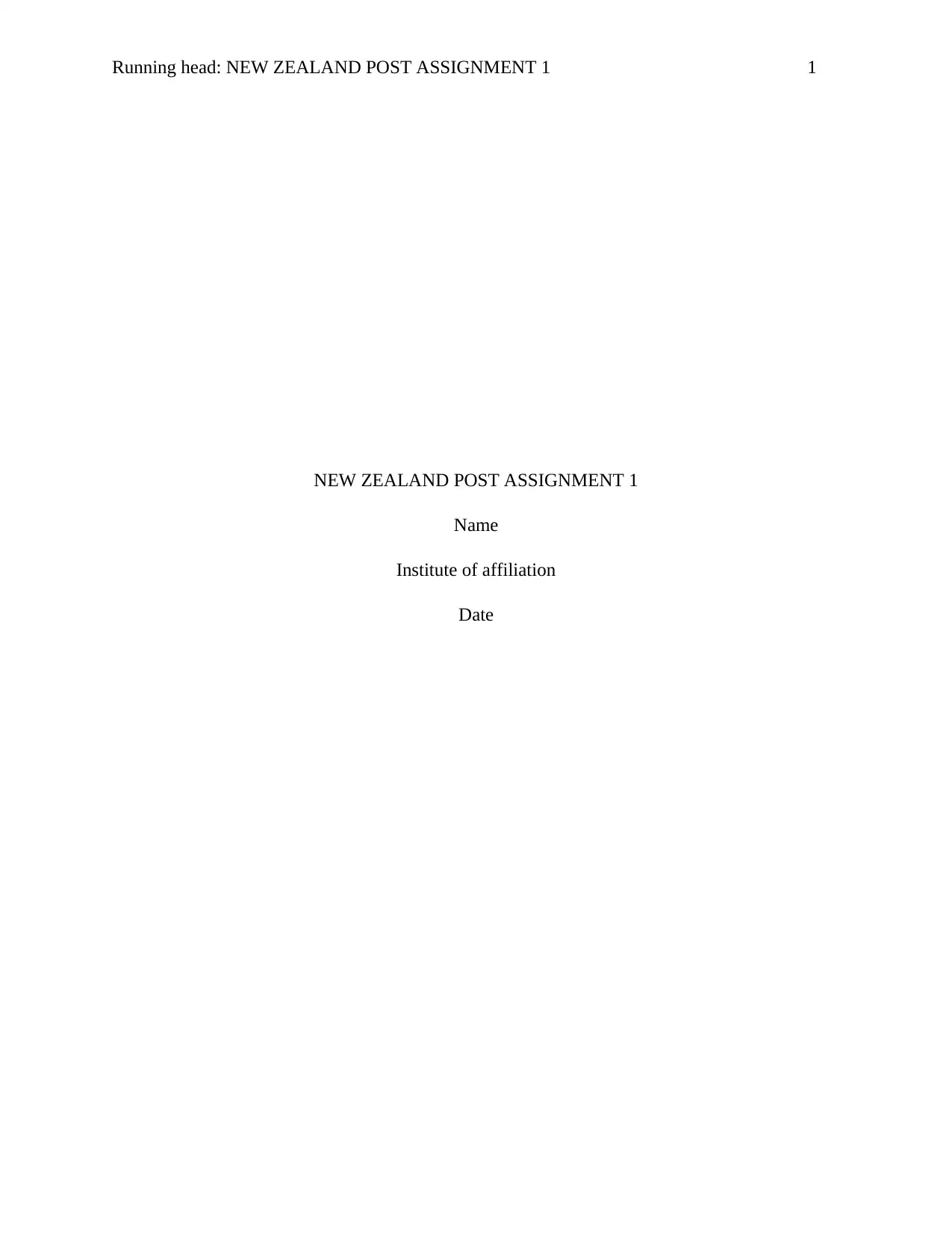
Running head: NEW ZEALAND POST ASSIGNMENT 1 1
NEW ZEALAND POST ASSIGNMENT 1
Name
Institute of affiliation
Date
NEW ZEALAND POST ASSIGNMENT 1
Name
Institute of affiliation
Date
Paraphrase This Document
Need a fresh take? Get an instant paraphrase of this document with our AI Paraphraser
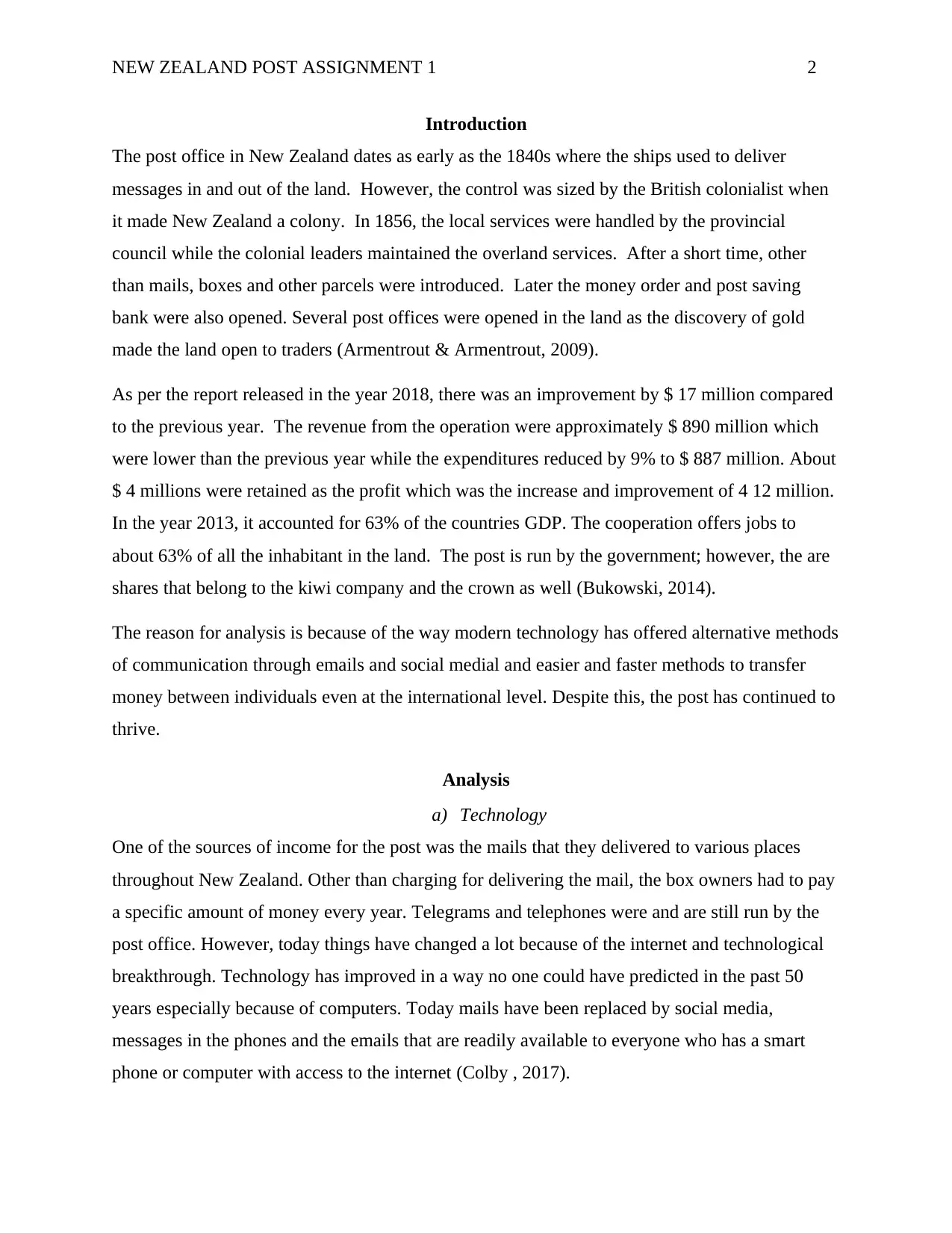
NEW ZEALAND POST ASSIGNMENT 1 2
Introduction
The post office in New Zealand dates as early as the 1840s where the ships used to deliver
messages in and out of the land. However, the control was sized by the British colonialist when
it made New Zealand a colony. In 1856, the local services were handled by the provincial
council while the colonial leaders maintained the overland services. After a short time, other
than mails, boxes and other parcels were introduced. Later the money order and post saving
bank were also opened. Several post offices were opened in the land as the discovery of gold
made the land open to traders (Armentrout & Armentrout, 2009).
As per the report released in the year 2018, there was an improvement by $ 17 million compared
to the previous year. The revenue from the operation were approximately $ 890 million which
were lower than the previous year while the expenditures reduced by 9% to $ 887 million. About
$ 4 millions were retained as the profit which was the increase and improvement of 4 12 million.
In the year 2013, it accounted for 63% of the countries GDP. The cooperation offers jobs to
about 63% of all the inhabitant in the land. The post is run by the government; however, the are
shares that belong to the kiwi company and the crown as well (Bukowski, 2014).
The reason for analysis is because of the way modern technology has offered alternative methods
of communication through emails and social medial and easier and faster methods to transfer
money between individuals even at the international level. Despite this, the post has continued to
thrive.
Analysis
a) Technology
One of the sources of income for the post was the mails that they delivered to various places
throughout New Zealand. Other than charging for delivering the mail, the box owners had to pay
a specific amount of money every year. Telegrams and telephones were and are still run by the
post office. However, today things have changed a lot because of the internet and technological
breakthrough. Technology has improved in a way no one could have predicted in the past 50
years especially because of computers. Today mails have been replaced by social media,
messages in the phones and the emails that are readily available to everyone who has a smart
phone or computer with access to the internet (Colby , 2017).
Introduction
The post office in New Zealand dates as early as the 1840s where the ships used to deliver
messages in and out of the land. However, the control was sized by the British colonialist when
it made New Zealand a colony. In 1856, the local services were handled by the provincial
council while the colonial leaders maintained the overland services. After a short time, other
than mails, boxes and other parcels were introduced. Later the money order and post saving
bank were also opened. Several post offices were opened in the land as the discovery of gold
made the land open to traders (Armentrout & Armentrout, 2009).
As per the report released in the year 2018, there was an improvement by $ 17 million compared
to the previous year. The revenue from the operation were approximately $ 890 million which
were lower than the previous year while the expenditures reduced by 9% to $ 887 million. About
$ 4 millions were retained as the profit which was the increase and improvement of 4 12 million.
In the year 2013, it accounted for 63% of the countries GDP. The cooperation offers jobs to
about 63% of all the inhabitant in the land. The post is run by the government; however, the are
shares that belong to the kiwi company and the crown as well (Bukowski, 2014).
The reason for analysis is because of the way modern technology has offered alternative methods
of communication through emails and social medial and easier and faster methods to transfer
money between individuals even at the international level. Despite this, the post has continued to
thrive.
Analysis
a) Technology
One of the sources of income for the post was the mails that they delivered to various places
throughout New Zealand. Other than charging for delivering the mail, the box owners had to pay
a specific amount of money every year. Telegrams and telephones were and are still run by the
post office. However, today things have changed a lot because of the internet and technological
breakthrough. Technology has improved in a way no one could have predicted in the past 50
years especially because of computers. Today mails have been replaced by social media,
messages in the phones and the emails that are readily available to everyone who has a smart
phone or computer with access to the internet (Colby , 2017).
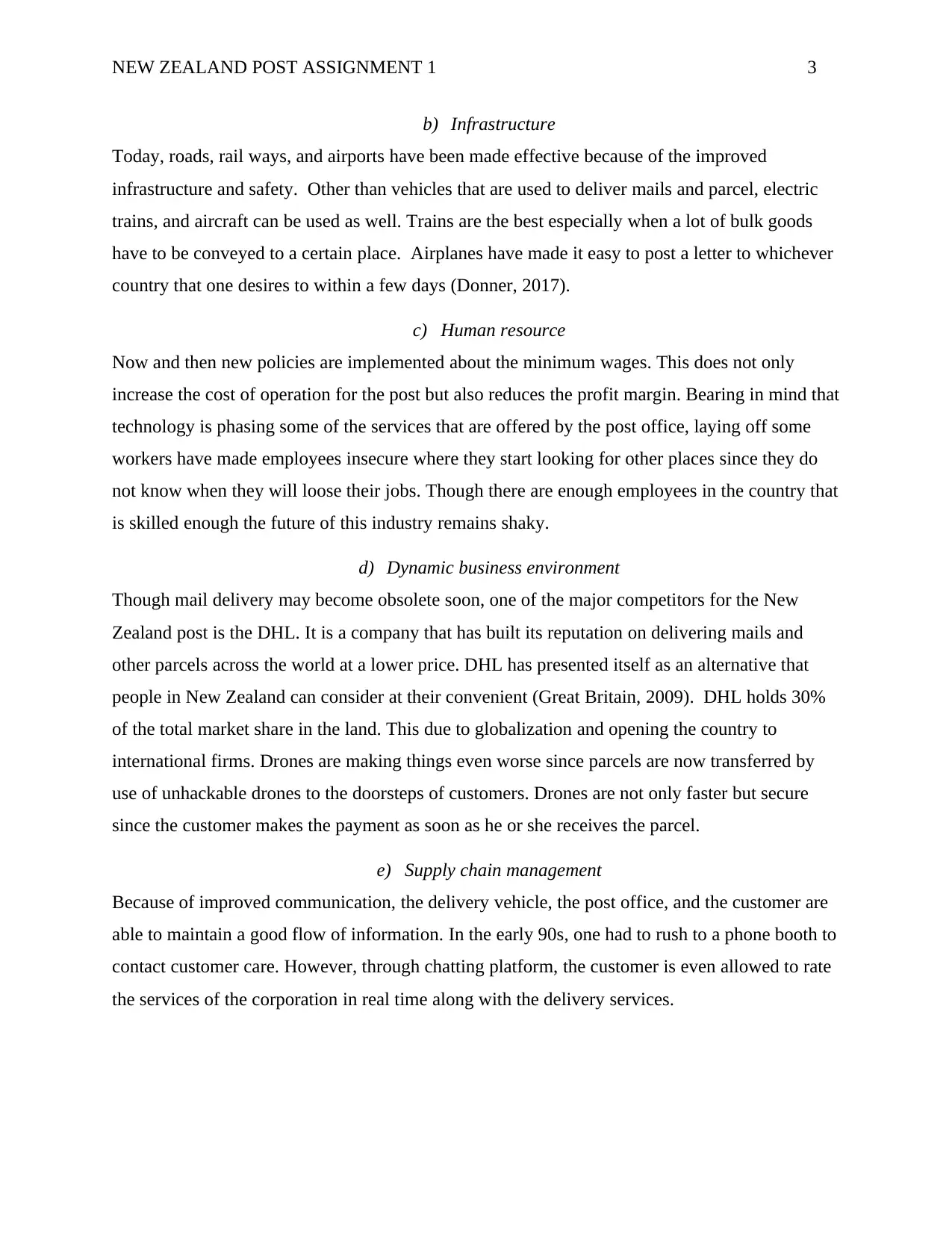
NEW ZEALAND POST ASSIGNMENT 1 3
b) Infrastructure
Today, roads, rail ways, and airports have been made effective because of the improved
infrastructure and safety. Other than vehicles that are used to deliver mails and parcel, electric
trains, and aircraft can be used as well. Trains are the best especially when a lot of bulk goods
have to be conveyed to a certain place. Airplanes have made it easy to post a letter to whichever
country that one desires to within a few days (Donner, 2017).
c) Human resource
Now and then new policies are implemented about the minimum wages. This does not only
increase the cost of operation for the post but also reduces the profit margin. Bearing in mind that
technology is phasing some of the services that are offered by the post office, laying off some
workers have made employees insecure where they start looking for other places since they do
not know when they will loose their jobs. Though there are enough employees in the country that
is skilled enough the future of this industry remains shaky.
d) Dynamic business environment
Though mail delivery may become obsolete soon, one of the major competitors for the New
Zealand post is the DHL. It is a company that has built its reputation on delivering mails and
other parcels across the world at a lower price. DHL has presented itself as an alternative that
people in New Zealand can consider at their convenient (Great Britain, 2009). DHL holds 30%
of the total market share in the land. This due to globalization and opening the country to
international firms. Drones are making things even worse since parcels are now transferred by
use of unhackable drones to the doorsteps of customers. Drones are not only faster but secure
since the customer makes the payment as soon as he or she receives the parcel.
e) Supply chain management
Because of improved communication, the delivery vehicle, the post office, and the customer are
able to maintain a good flow of information. In the early 90s, one had to rush to a phone booth to
contact customer care. However, through chatting platform, the customer is even allowed to rate
the services of the corporation in real time along with the delivery services.
b) Infrastructure
Today, roads, rail ways, and airports have been made effective because of the improved
infrastructure and safety. Other than vehicles that are used to deliver mails and parcel, electric
trains, and aircraft can be used as well. Trains are the best especially when a lot of bulk goods
have to be conveyed to a certain place. Airplanes have made it easy to post a letter to whichever
country that one desires to within a few days (Donner, 2017).
c) Human resource
Now and then new policies are implemented about the minimum wages. This does not only
increase the cost of operation for the post but also reduces the profit margin. Bearing in mind that
technology is phasing some of the services that are offered by the post office, laying off some
workers have made employees insecure where they start looking for other places since they do
not know when they will loose their jobs. Though there are enough employees in the country that
is skilled enough the future of this industry remains shaky.
d) Dynamic business environment
Though mail delivery may become obsolete soon, one of the major competitors for the New
Zealand post is the DHL. It is a company that has built its reputation on delivering mails and
other parcels across the world at a lower price. DHL has presented itself as an alternative that
people in New Zealand can consider at their convenient (Great Britain, 2009). DHL holds 30%
of the total market share in the land. This due to globalization and opening the country to
international firms. Drones are making things even worse since parcels are now transferred by
use of unhackable drones to the doorsteps of customers. Drones are not only faster but secure
since the customer makes the payment as soon as he or she receives the parcel.
e) Supply chain management
Because of improved communication, the delivery vehicle, the post office, and the customer are
able to maintain a good flow of information. In the early 90s, one had to rush to a phone booth to
contact customer care. However, through chatting platform, the customer is even allowed to rate
the services of the corporation in real time along with the delivery services.
⊘ This is a preview!⊘
Do you want full access?
Subscribe today to unlock all pages.

Trusted by 1+ million students worldwide
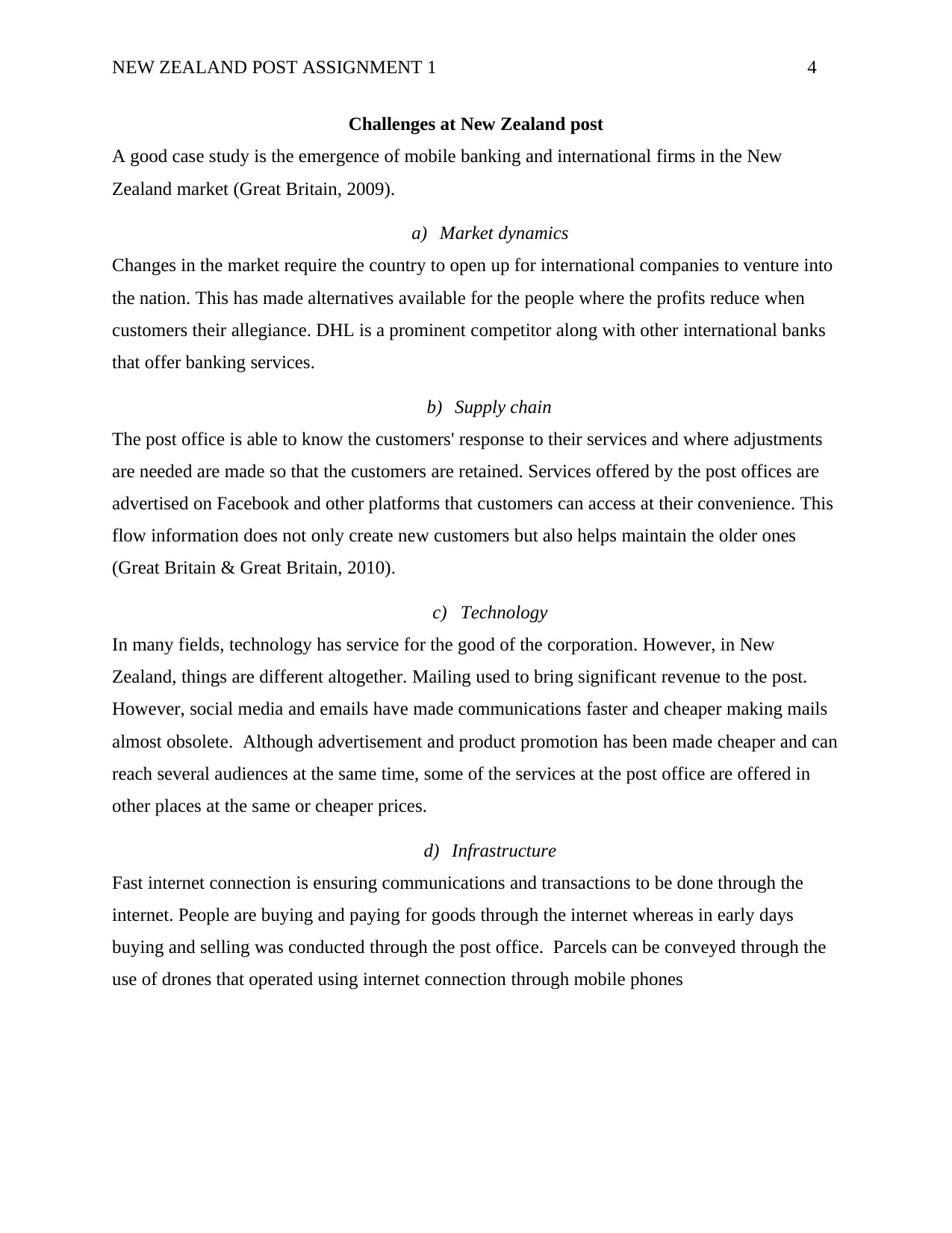
NEW ZEALAND POST ASSIGNMENT 1 4
Challenges at New Zealand post
A good case study is the emergence of mobile banking and international firms in the New
Zealand market (Great Britain, 2009).
a) Market dynamics
Changes in the market require the country to open up for international companies to venture into
the nation. This has made alternatives available for the people where the profits reduce when
customers their allegiance. DHL is a prominent competitor along with other international banks
that offer banking services.
b) Supply chain
The post office is able to know the customers' response to their services and where adjustments
are needed are made so that the customers are retained. Services offered by the post offices are
advertised on Facebook and other platforms that customers can access at their convenience. This
flow information does not only create new customers but also helps maintain the older ones
(Great Britain & Great Britain, 2010).
c) Technology
In many fields, technology has service for the good of the corporation. However, in New
Zealand, things are different altogether. Mailing used to bring significant revenue to the post.
However, social media and emails have made communications faster and cheaper making mails
almost obsolete. Although advertisement and product promotion has been made cheaper and can
reach several audiences at the same time, some of the services at the post office are offered in
other places at the same or cheaper prices.
d) Infrastructure
Fast internet connection is ensuring communications and transactions to be done through the
internet. People are buying and paying for goods through the internet whereas in early days
buying and selling was conducted through the post office. Parcels can be conveyed through the
use of drones that operated using internet connection through mobile phones
Challenges at New Zealand post
A good case study is the emergence of mobile banking and international firms in the New
Zealand market (Great Britain, 2009).
a) Market dynamics
Changes in the market require the country to open up for international companies to venture into
the nation. This has made alternatives available for the people where the profits reduce when
customers their allegiance. DHL is a prominent competitor along with other international banks
that offer banking services.
b) Supply chain
The post office is able to know the customers' response to their services and where adjustments
are needed are made so that the customers are retained. Services offered by the post offices are
advertised on Facebook and other platforms that customers can access at their convenience. This
flow information does not only create new customers but also helps maintain the older ones
(Great Britain & Great Britain, 2010).
c) Technology
In many fields, technology has service for the good of the corporation. However, in New
Zealand, things are different altogether. Mailing used to bring significant revenue to the post.
However, social media and emails have made communications faster and cheaper making mails
almost obsolete. Although advertisement and product promotion has been made cheaper and can
reach several audiences at the same time, some of the services at the post office are offered in
other places at the same or cheaper prices.
d) Infrastructure
Fast internet connection is ensuring communications and transactions to be done through the
internet. People are buying and paying for goods through the internet whereas in early days
buying and selling was conducted through the post office. Parcels can be conveyed through the
use of drones that operated using internet connection through mobile phones
Paraphrase This Document
Need a fresh take? Get an instant paraphrase of this document with our AI Paraphraser
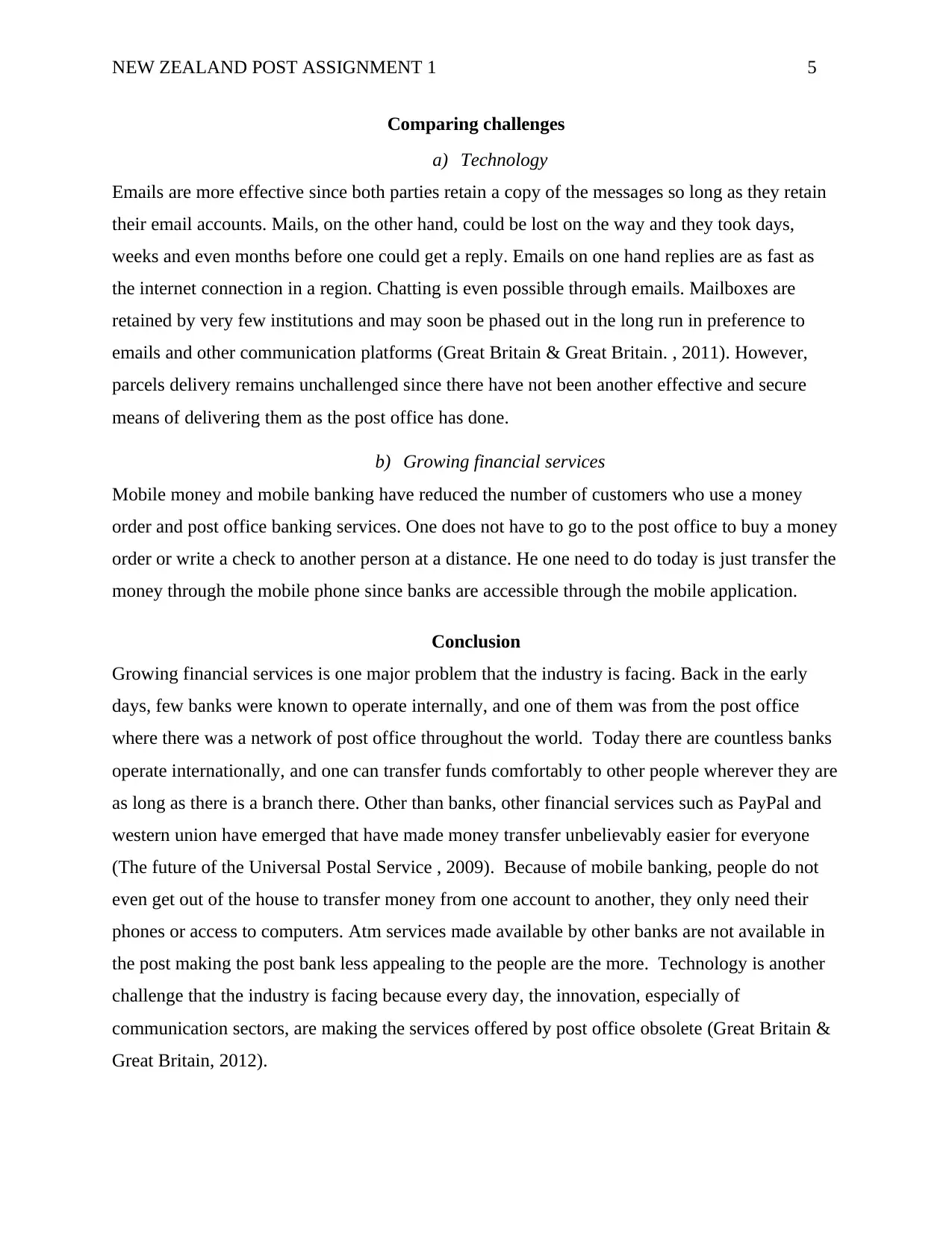
NEW ZEALAND POST ASSIGNMENT 1 5
Comparing challenges
a) Technology
Emails are more effective since both parties retain a copy of the messages so long as they retain
their email accounts. Mails, on the other hand, could be lost on the way and they took days,
weeks and even months before one could get a reply. Emails on one hand replies are as fast as
the internet connection in a region. Chatting is even possible through emails. Mailboxes are
retained by very few institutions and may soon be phased out in the long run in preference to
emails and other communication platforms (Great Britain & Great Britain. , 2011). However,
parcels delivery remains unchallenged since there have not been another effective and secure
means of delivering them as the post office has done.
b) Growing financial services
Mobile money and mobile banking have reduced the number of customers who use a money
order and post office banking services. One does not have to go to the post office to buy a money
order or write a check to another person at a distance. He one need to do today is just transfer the
money through the mobile phone since banks are accessible through the mobile application.
Conclusion
Growing financial services is one major problem that the industry is facing. Back in the early
days, few banks were known to operate internally, and one of them was from the post office
where there was a network of post office throughout the world. Today there are countless banks
operate internationally, and one can transfer funds comfortably to other people wherever they are
as long as there is a branch there. Other than banks, other financial services such as PayPal and
western union have emerged that have made money transfer unbelievably easier for everyone
(The future of the Universal Postal Service , 2009). Because of mobile banking, people do not
even get out of the house to transfer money from one account to another, they only need their
phones or access to computers. Atm services made available by other banks are not available in
the post making the post bank less appealing to the people are the more. Technology is another
challenge that the industry is facing because every day, the innovation, especially of
communication sectors, are making the services offered by post office obsolete (Great Britain &
Great Britain, 2012).
Comparing challenges
a) Technology
Emails are more effective since both parties retain a copy of the messages so long as they retain
their email accounts. Mails, on the other hand, could be lost on the way and they took days,
weeks and even months before one could get a reply. Emails on one hand replies are as fast as
the internet connection in a region. Chatting is even possible through emails. Mailboxes are
retained by very few institutions and may soon be phased out in the long run in preference to
emails and other communication platforms (Great Britain & Great Britain. , 2011). However,
parcels delivery remains unchallenged since there have not been another effective and secure
means of delivering them as the post office has done.
b) Growing financial services
Mobile money and mobile banking have reduced the number of customers who use a money
order and post office banking services. One does not have to go to the post office to buy a money
order or write a check to another person at a distance. He one need to do today is just transfer the
money through the mobile phone since banks are accessible through the mobile application.
Conclusion
Growing financial services is one major problem that the industry is facing. Back in the early
days, few banks were known to operate internally, and one of them was from the post office
where there was a network of post office throughout the world. Today there are countless banks
operate internationally, and one can transfer funds comfortably to other people wherever they are
as long as there is a branch there. Other than banks, other financial services such as PayPal and
western union have emerged that have made money transfer unbelievably easier for everyone
(The future of the Universal Postal Service , 2009). Because of mobile banking, people do not
even get out of the house to transfer money from one account to another, they only need their
phones or access to computers. Atm services made available by other banks are not available in
the post making the post bank less appealing to the people are the more. Technology is another
challenge that the industry is facing because every day, the innovation, especially of
communication sectors, are making the services offered by post office obsolete (Great Britain &
Great Britain, 2012).

NEW ZEALAND POST ASSIGNMENT 1 6
Human resource is a major challenge faced by the New Zealand post office. Every time
technology phases out the services of the post office, someone losses a job. Having insecure
employees causes them to underperform since they do not know when they will lose their job.
Open the country to international companies have made DHL, the main competitor in delivering
letters, to enter the market reducing the market share that the New Zealand post have. Profits
margin reduce as a result.
Reference
Armentrout, D., & Armentrout, P. (2009). The post office. Vero Beach, FL: Rourke Pub.
Bukowski, C. (2014). Post office: A novel. New York, NY: Ecco, an imprint of Harper Collins.
Colby, J. (2017). Post office. Ann Arbor, MI: Cherry Lake Publishing.
Donner, E. (2017). Post office. Minneapolis, MN: Jump!
Great Britain. (2009). Oversight of the Post Office network change programme: Department for
Business, Enterprise and Regulatory Reform. London: Stationery Office.
Great Britain. (2009). The Postal Services Bill. London: TSO.
Great Britain., & Great Britain. (2010). Post offices - securing their future: Eighth report of
session 2008-10. London: Stationery Office.
Great Britain., & Great Britain. (2011). Postal services in Scotland: First report of session 2010-
11. London: Stationery Office.
Human resource is a major challenge faced by the New Zealand post office. Every time
technology phases out the services of the post office, someone losses a job. Having insecure
employees causes them to underperform since they do not know when they will lose their job.
Open the country to international companies have made DHL, the main competitor in delivering
letters, to enter the market reducing the market share that the New Zealand post have. Profits
margin reduce as a result.
Reference
Armentrout, D., & Armentrout, P. (2009). The post office. Vero Beach, FL: Rourke Pub.
Bukowski, C. (2014). Post office: A novel. New York, NY: Ecco, an imprint of Harper Collins.
Colby, J. (2017). Post office. Ann Arbor, MI: Cherry Lake Publishing.
Donner, E. (2017). Post office. Minneapolis, MN: Jump!
Great Britain. (2009). Oversight of the Post Office network change programme: Department for
Business, Enterprise and Regulatory Reform. London: Stationery Office.
Great Britain. (2009). The Postal Services Bill. London: TSO.
Great Britain., & Great Britain. (2010). Post offices - securing their future: Eighth report of
session 2008-10. London: Stationery Office.
Great Britain., & Great Britain. (2011). Postal services in Scotland: First report of session 2010-
11. London: Stationery Office.
⊘ This is a preview!⊘
Do you want full access?
Subscribe today to unlock all pages.

Trusted by 1+ million students worldwide
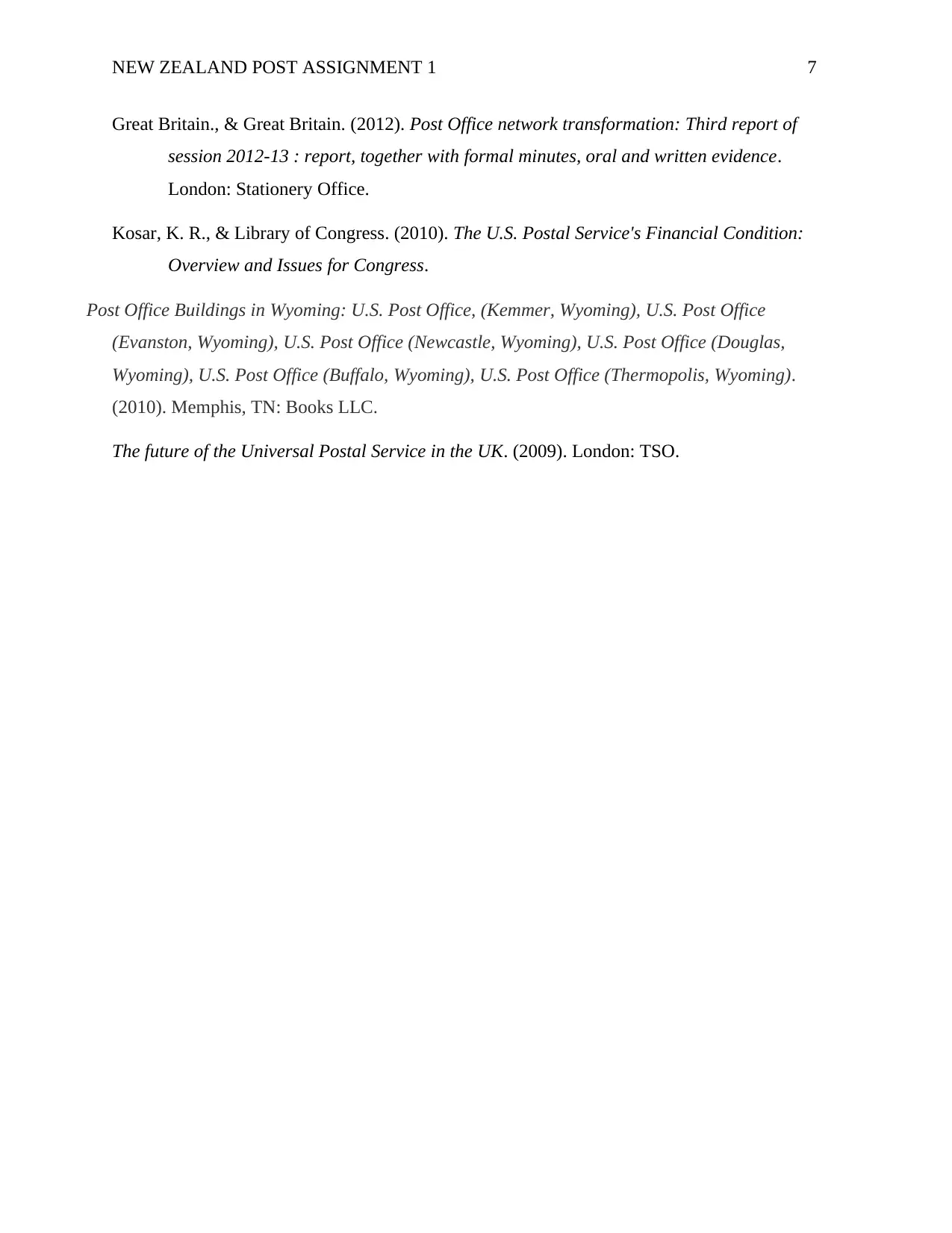
NEW ZEALAND POST ASSIGNMENT 1 7
Great Britain., & Great Britain. (2012). Post Office network transformation: Third report of
session 2012-13 : report, together with formal minutes, oral and written evidence.
London: Stationery Office.
Kosar, K. R., & Library of Congress. (2010). The U.S. Postal Service's Financial Condition:
Overview and Issues for Congress.
Post Office Buildings in Wyoming: U.S. Post Office, (Kemmer, Wyoming), U.S. Post Office
(Evanston, Wyoming), U.S. Post Office (Newcastle, Wyoming), U.S. Post Office (Douglas,
Wyoming), U.S. Post Office (Buffalo, Wyoming), U.S. Post Office (Thermopolis, Wyoming).
(2010). Memphis, TN: Books LLC.
The future of the Universal Postal Service in the UK. (2009). London: TSO.
Great Britain., & Great Britain. (2012). Post Office network transformation: Third report of
session 2012-13 : report, together with formal minutes, oral and written evidence.
London: Stationery Office.
Kosar, K. R., & Library of Congress. (2010). The U.S. Postal Service's Financial Condition:
Overview and Issues for Congress.
Post Office Buildings in Wyoming: U.S. Post Office, (Kemmer, Wyoming), U.S. Post Office
(Evanston, Wyoming), U.S. Post Office (Newcastle, Wyoming), U.S. Post Office (Douglas,
Wyoming), U.S. Post Office (Buffalo, Wyoming), U.S. Post Office (Thermopolis, Wyoming).
(2010). Memphis, TN: Books LLC.
The future of the Universal Postal Service in the UK. (2009). London: TSO.
1 out of 7
Related Documents
Your All-in-One AI-Powered Toolkit for Academic Success.
+13062052269
info@desklib.com
Available 24*7 on WhatsApp / Email
![[object Object]](/_next/static/media/star-bottom.7253800d.svg)
Unlock your academic potential
Copyright © 2020–2025 A2Z Services. All Rights Reserved. Developed and managed by ZUCOL.




